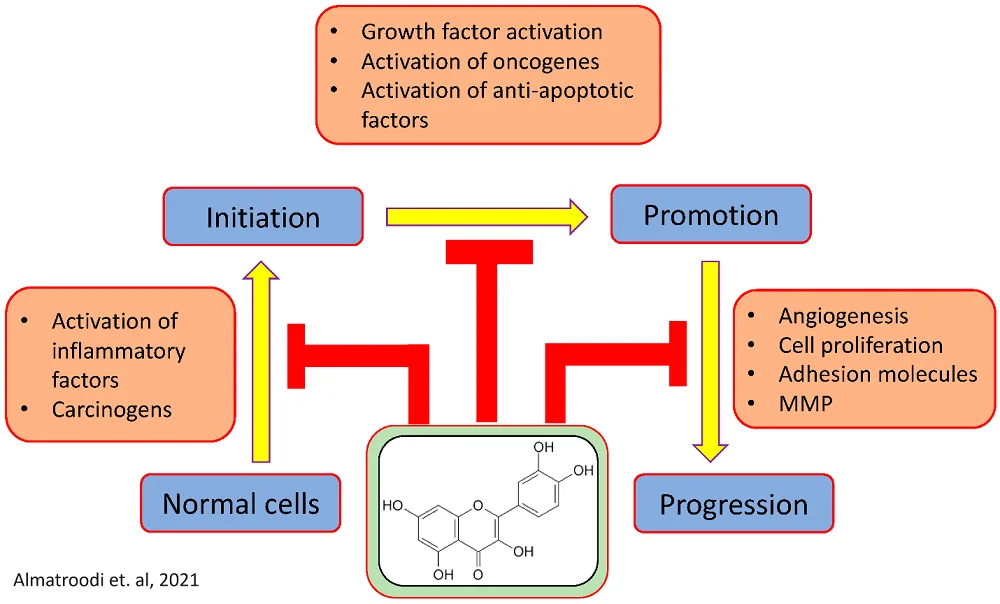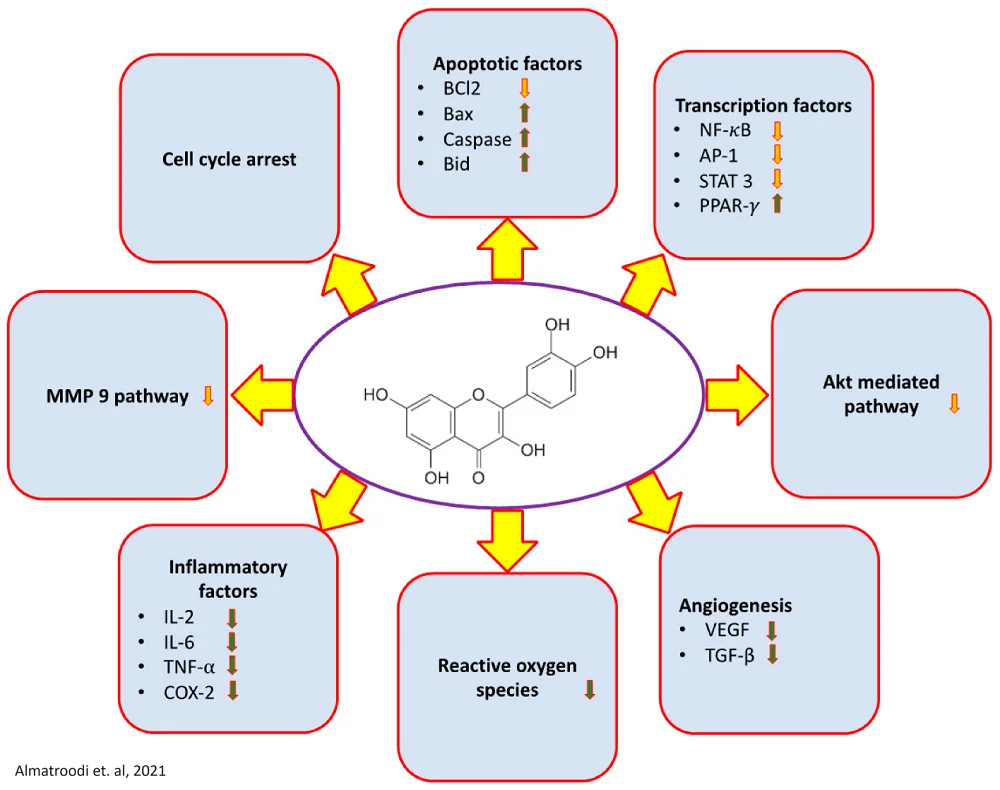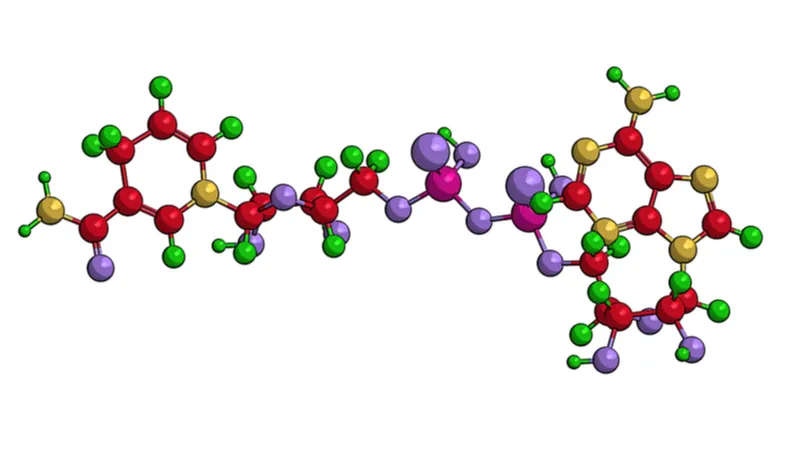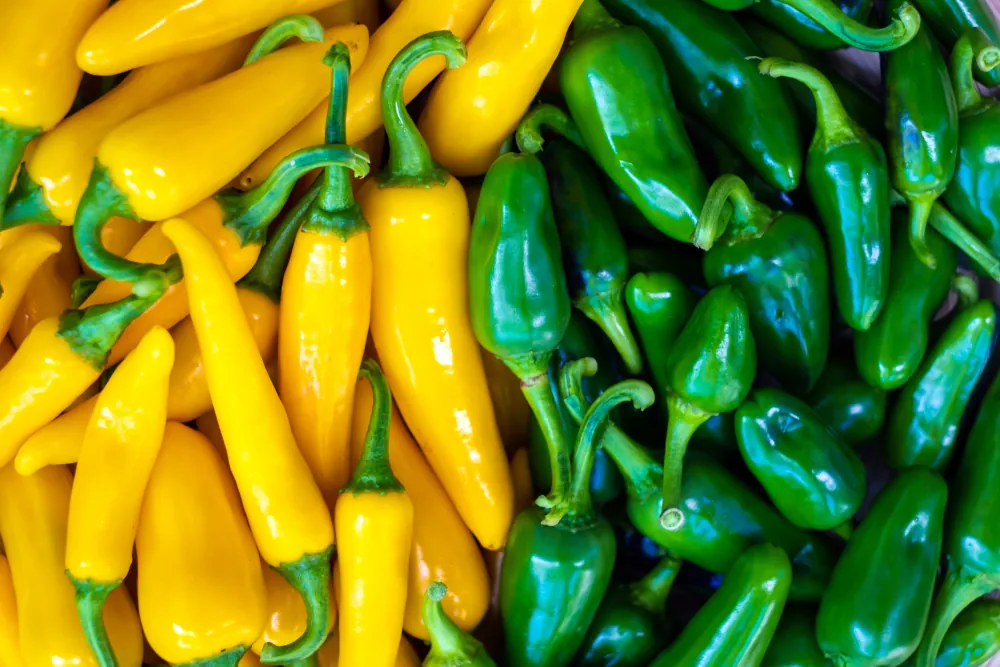Quercetin: Benefits, Side Effects, and Research
Found in many fruits and vegetables, quercetin is a natural antioxidant and popular dietary supplement that may have some potential against aging.
What is quercetin?
Quercetin is an evolutionarily conserved natural flavonoid, which makes it part of a large family of water-soluble plant compounds. Although quercetin is classified as a water-soluble compound, its ring structures and other chemical features allow it to penetrate the lipid bilayer of the cell membrane as well as the nuclear membrane. It can also make use of other transport mechanisms to move about the cell, contributing to its remarkable number of cellular effects.
Albert Szent-Györgyi discovered flavonoids in 1936 while researching ways to treat scurvy. He won the Nobel Prize in 1937 for his “discoveries in connection with the biological combustion processes with special reference to vitamin C and the catalysis of fumaric acid”.
We have much to thank him for, especially his discovery of the flavonoids, particularly quercetin. Flavonoids were once known as vitamin P, for permeability. This was because some flavonoids can influence the permeability of blood vessel walls. Flavonoids are not created by the body and are an important part of a healthy diet.
What is quercetin used for?
Traditionally, people take quercetin because they believe it is effective in supporting the brain and immune system, slowing down skin aging, improving NAD+ levels, removing senescent cells as a senolytic, reducing blood pressure, and alleviating allergies.
What does quercetin do?
Quercetin functions as an antioxidant and anti-inflammatory. One way quercetin reduces inflammation is by reducing the inflammatory response of macrophages. It also has been found to drive apoptosis, inhibit the cell cycle, inhibit angiogenesis (new blood cell formation), and cell differentiation, often through multiple mechanisms. This makes quercetin a compound of interest in both the treatment of cancer and the removal of senescent cells, a key hallmark of aging [1].
A bounty of research suggests many of quercetin’s effects, such as apoptosis of senescent cells, can be amplified when combined with other drugs, particularly dasatinib. This potent combination can be harnessed to treat a range of disorders, including intervertebral disc degeneration, obesity-induced metabolic dysfunction, age-related changes in the gut microbiome and barrier function, and many other senescence-related disorders as well as cancers.
Research spearheaded by Novais in 2021 has showcased quercetin’s remarkable potential as a senolytic agent in combination with dasatinib preserving the integrity of intervertebral discs in mice. Intervertebral disc degeneration, which is influenced by cellular senescence, is highly prevalent within the elderly population and is a leading cause of chronic back pain and disability. A synergistic approach with quercetin mitigates age-related degeneration, offering a beacon of hope for addressing the chronic back pain and disability that often accompany advancing years [2].
A 2020 study by Sierra-Ramirez demonstrated quercetin’s capacity to reduce the impact of obesity-induced metabolic disorders. Through its anti-inflammatory effects, quercetin not only alleviated the burden of senescent cells in adipose tissue but also improved metabolic parameters, helping to fight against obesity and its associated complications [3].
In 2021, Saccon and company investigated the effects of quercetin on gastrointestinal senescence and inflammation. By diminishing senescence and inflammation within the intestines, quercetin not only fostered a healthier cellular environment but also orchestrated a beneficial shift in the gut microbiome. This dual action underscores quercetin’s capacity to enhance gut health and stave off the detrimental effects of aging on digestive function [4].
Evidence suggests that quercetin independently inhibits cancer initiation, promotion, and progression. Its ability to reduce inflammation, drive apoptosis, inhibit the cell cycle, and reduce oxidative damage likely accounts for its effects on a broad spectrum of disorders in addition to cancer.

The mechanisms through which quercetin exerts these effects have been linked to inhibitory activity in a wide variety of cellular signaling networks, including NF-κB and its associated inflammatory mediators, the Akt pathway, which regulates cell proliferation, autophagy, new blood vessel formation, and cell survival, and other pathways, such as MMP-9, which enable cancer cells to metastasize. Its senolytic effects likely stem from its inhibition of molecules that include BCL2, Bax, Caspase, and Bid [5].

One striking feature of quercetin’s effects is that they are quite selective. Quercetin does not cause random apoptosis but specifically apoptosis in senescent and cancer cells. Quercetin works particularly well with dasatinib, as each compound targets apoptosis pathways that the other does not.
Foods rich in quercetin
Quercetin is present in a variety of fruits and vegetables.
| Food | Quercetin (mg per 100 g) |
| Raw capers | 233.84 |
| Raw hot/yellow peppers | 50.73 |
| Raw red onions | 39.21 |
| Cooked asparagus | 15.16 |
| Raw cranberries | 14.84 |
| Raw hot/green peppers | 14.7 |
| Raw lingonberries | 13.3 |
| Raw blueberries | 7.67 |
| Raw red leaf lettuce | 7.61 |
| Raw white onions | 6.17 |
| Tinned tomatoes | 4.12 |
| Red apples | 3.86 |
| Gala apples | 3.8 |
| Golden delicious apples | 3.69 |
| Raw broccoli | 3.26 |
| Raw sweet cherries | 2.29 |
| Black grapes | 2.08 |
| White grapes | 1.12 |
Due to the variable nature of dietary sources, many people opt to use quercetin supplements. A typical dietary supplement contains 500 mg of quercetin, which is many times higher than is typically present in the average diet.
Isoquercetin (also known as isoquercitrin) is related to quercetin and has better bioavailability [6]. It is harder to get than regular quercetin and may be more expensive, though smaller amounts are required, as it is around six times more potent.
Potential antioxidant benefits
Some data suggests that quercetin intake may have a beneficial impact on general health. For example, oxygen free radicals are a byproduct of mitochondrial energy production and contribute to aging. Quercetin neutralizes and scavenges reactive oxygen and nitrogen species [7, 8], making it an antioxidant. It also has anti-bacterial [9, 10], anti-inflammatory [11], and anti-carcinogenic [12-17] properties.
Quercetin supports efficient protein production
Quercetin can enhance proteolysis and maintain proteostasis [18, 19], the proper creation and maintenance of proteins in cells. The loss of proteostasis leads to misfolded proteins and is another reason we age.
In a more recent finding, Xiaojing Wang’s October 2023 study investigated how quercetin might help treat ulcerative colitis, a chronic condition that causes inflammation and ulcers in the digestive tract. The study found that quercetin works by activating a specific protein in the body that helps to repair and maintain the intestinal barrier. This action helps to keep the gut lining strong and prevents harmful substances from causing inflammation. Mouse and cell models have determined that quercetin can effectively reduce symptoms of ulcerative colitis by enhancing the body’s natural defenses against inflammation and damage in the gut [20].
Quercetin appears to support the brain and immune system
Animal studies with aged mice showed that quercetin improved general and spatial awareness [21]. The same mice also had an increased level of exploratory behavior, which is typically seen in younger mice. Another study showed an improvement of the immune cells of artificially aged progeric mice [22]. While these mice are not an exact emulation of aging, they do provide useful data for studying aging.
Quercetin may slow down skin aging
Topical treatment increases the hydration and elasticity of the skin, reducing wrinkles [23]. The skin is also easy to access, unlike internal organs, making it an ideal target for anti-aging studies using flavonoids. Quercetin has also shown efficacy in treating skin disorders such as dermatitis [24-26]. These effects make sense in light of quercetin’s role in plants, where it protects a wide range of plant species from UV damage and other environmental exposures.
Quercetin may improve NAD+ levels
This compound reduces inflammation and increases NAD+ levels by reducing inflammatory factors such as CD38 [27, 28]. NAD+ is in every cell, interacts with sirtuins to regulate metabolism, and plays a role in health and longevity. CD38 increases with age and consumes NAD+, making metabolism increasingly dysfunctional.

Read More
Quercetin as a senolytic
As we age, increasing amounts of dysfunctional, non-dividing senescent cells accumulate. These damaged cells are normally removed by the immune system, but as we age, this system declines and more and more of these cells build up. Senescent cell accumulation is another reason we age.

Read More
Senolytics are compounds that can induce senescent cells to enter apoptosis. Inducing this cellular self destruct could be a potential way of dealing with accumulated senescent cells.
Quercetin reduces inflammation by inhibiting some elements of the SASP. It can also directly induce apoptosis when used in combination with other drugs to improve vascular health [29, 30].
Quercetin may help with blood pressure and allergies
This flavonoid has shown promise in reducing blood pressure, with some positive results for people with hypertension [31]. A detailed meta-analysis on quercetin and blood pressure was also conducted [32].
Quercetin has also been found to halt immune cells from releasing histamines, chemicals that trigger allergic reactions. This antihistamine effect may reduce the symptoms of allergies, such as runny nose, watery eyes, hives, and facial swelling.
Repackaging quercetin may help treat acute kidney injury and other ailments
Acute kidney injury (AKI) is a serious condition in which the kidneys suddenly stop working properly, causing inflammation and damage due to oxidative stress, and it can be very dangerous for patients.
Quercetin is not especially stable in the body and doesn’t always get to where it needs to go effectively. Therefore, Pan and colleagues developed a nanozyme by combining ruthenium (Ru) and platinum (Pt) and then attaching quercetin to it.
The aim was to enhance the antioxidant power of quercetin. Results from their work indicated that the quercetin nanozyme was much better at capturing harmful molecules and protecting cells from damage, especially in a test-tube setup where cells were exposed to harmful conditions.
Safety of quercetin and its side effects
No serious adverse effects from quercetin use have been reported. In fact, studies have shown that it can be taken safely at 500 mg twice daily for 12 weeks. Longer-term use and higher doses remain an unknown at this time. Some people may experience headaches, stomachaches, or tingling sensations if taking more than 1000 mg of quercetin in a day. Anyone experiencing adverse effects from a supplement should cease taking it and consult a medical professional.
Disclaimer
This article is only a very brief summary. It is not intended as an exhaustive guide and is based on the interpretation of research data, which is speculative by nature. This article is not a substitute for consulting your physician about which supplements may or may not be right for you. We do not endorse supplement use or any product or supplement vendor, and all discussion here is for scientific interest.
Literature
[1] López-Otín, C.; Blasco, M.A.; Partridge, L.; Serrano, M.; Kroemer, G. The Hallmarks of Aging. Cell 2013 , 153 , 1194.
[2] Novais, E.J.; Tran, V.A.; Johnston, S.N.; Darris, K.R.; Roupas, A.J.; Sessions, G.A.; Shapiro, I.M.; Diekman, B.O.; Risbud, M. V. Long-Term Treatment with Senolytic Drugs Dasatinib and Quercetin Ameliorates Age-Dependent Intervertebral Disc Degeneration in Mice. Nature Communications 2021 12:1 2021 , 12 , 1–17.
[3] Sierra-Ramirez, A.; López-Aceituno, J.L.; Costa-Machado, L.F.; Plaza, A.; Barradas, M.; Fernandez-Marcos, P.J. Transient Metabolic Improvement in Obese Mice Treated with Navitoclax or Dasatinib/Quercetin. Aging (Albany NY) 2020 , 12 , 11337
[4] Saccon, T.D.; Nagpal, R.; Yadav, H.; Cavalcante, M.B.; Nunes, A.D.D.C.; Schneider, A.; Gesing, A.; Hughes, B.; Yousefzadeh, M.; Tchkonia, T.; et al. Senolytic Combination of Dasatinib and Quercetin Alleviates Intestinal Senescence and Inflammation and Modulates the Gut Microbiome in Aged Mice. The Journals of Gerontology: Series A 2021 , 76 , 1895–1905.
[5] Almatroodi, S.A.; Alsahli, M.A.; Almatroudi, A.; Verma, A.K.; Aloliqi, A.; Allemailem, K.S.; Khan, A.A.; Rahmani, A.H. Potential Therapeutic Targets of Quercetin, a Plant Flavonol, and Its Role in the Therapy of Various Types of Cancer through the Modulation of Various Cell Signaling Pathways. Molecules 2021, Vol. 26, Page 1315 2021 , 26 , 1315.
[6] Paulke, A., Eckert, G.P., Schubert-Zsilavecz, M., & Wurglics, M. (2012). Isoquercitrin provides better bioavailability than quercetin: comparison of quercetin metabolites in body tissue and brain sections after six days administration of isoquercitrin and quercetin. Die Pharmazie-An International Journal of Pharmaceutical Sciences, 67(12), 991-996.
[7] Hanasaki, Y., Ogawa, S., Fukui, S. (1994). The correlation between active oxygens scavenging and antioxidative effects of flavonoids . Free Radical Biology and Medicine, 16(6), 845-850.
[8] Van Acker, S.A., et al. (1996). Structural aspects of antioxidant activity of flavonoids. Free Radical Biology and Medicine, 20(3), 331-342 .
[9] Boots, A.W., Haenen, G.R., Bast, A. (2008). Health effects of quercetin: from antioxidant to nutraceutical. European Journal of Pharmacology, 585(2), 325-337.
[10] Cushnie, T.T., Lamb, A.J. (2005). Antimicrobial activity of flavonoids. International Journal of Antimicrobial Agents, 26(5), 343-356.
[11] Sen,G.,Biswas,D.,Ray,M.,Biswas,T.(2007). Albumin–quercetin combination offers a therapeutic advantage in the prevention of reduced survival of erythrocytes in visceral leishmaniasis. Blood Cells, Molecules, and Diseases, 39(3),245-254.
[12] Oršolić, N., et al. (2004). Immunomodulatory and antimetastatic action of propolis and related polyphenolic compounds. Journal of Ethnopharmacology, 94(2), 307-315.
[13] Gulati, N., et al. (2006). The antiproliferative effect of Quercetin in cancer cells is mediated via inhibition of the PI3K-Akt/PKB pathway. Anticancer Research, 26(2A), 1177-1181.
[14] Kuo, S.M. (1996). Antiproliferative potency of structurally distinct dietary flavonoids on human colon cancer cells. Cancer Letters, 110(1), 41-48.
[15] Landis ‐ Piwowar, K.R., Milacic, V., Dou, Q.P. (2008). Relationship between the methylation status of dietary flavonoids and their growth ‐ inhibitory and apoptosis ‐ inducing activities in human cancer cells. Journal of Cellular Biochemistry, 105(2), 514-523.
[16] Oršolić, N., et al. (2004). Immunomodulatory and antimetastatic action of propolis and related polyphenolic compounds. Journal of Ethnopharmacology, 94(2), 307-315.
[17] Zamin, L. L., et al. (2009). Resveratrol and quercetin cooperate to induce senescence ‐ like growth arrest in C6 rat glioma cells. Cancer Science, 100(9), 1655-1662.
[18] Trougakos, I.P., et al. (2003). Slowing down cellular aging in vitro. Modulating Aging and Longevity Kluwer Academic Publishers, 65-83.
[19] Chondrogianni, N., et al. (2010). Anti-ageing and rejuvenating effects of quercetin. Experimental Gerontology,45(10),763-771.
[20] Wang, X.; Xie, X.; Li, Y.; Xie, X.; Huang, S.; Pan, S.; Zou, Y.; Pan, Z.; Wang, Q.; Chen, J.; et al. Quercetin Ameliorates Ulcerative Colitis by Activating Aryl Hydrocarbon Receptor to Improve Intestinal Barrier Integrity. Phytotherapy Research 2024 , 38 , 253–264
[21] Liu, J., Yu, H., Ning, X. (2006). Effect of quercetin on chronic enhancement of spatial learning and memory of mice. Science in China Series C:Life Sciences,49(6),583-590.
[22] Álvarez, P., et al. (2006). Improvement of leukocyte functions in prematurely aging mice after five weeks of diet supplementation with polyphenol-rich cereals. Nutrition, 22(9), 913-921.
[23] Nebus, J., Vassilatou, K., Philippou, L., Wallo, W. (2011). Clinical improvements in facial photoaged skin using a novel oak quercetin topical preparation. Journal of the American Academy of Dermatology, 64(2): AB73-AB73.
[24] Jung, M.K., Hur, D.Y., Song, S.B., Park, Y., Kim, T.S., Bang, S.I., … & Cho, D.H. (2010). Tannic acid and quercetin display a therapeutic effect in atopic dermatitis via suppression of angiogenesis and TARC expression in Nc/Nga mice. Journal of Investigative Dermatology, 130(5), 1459-1463.
[25] Weng, Z., Zhang, B., Asadi, S., Sismanopoulos, N., Butcher, A., Fu, X., … & Theoharides, T.C. (2012). Quercetin is more effective than cromolyn in blocking human mast cell cytokine release and inhibits contact dermatitis and photosensitivity in humans. PLoS One, 7(3), e33805.
[26] Karuppagounder, V., Arumugam, S., Thandavarayan, R.A., Sreedhar, R., Giridharan, V. V., & Watanabe, K. (2016). Molecular targets of quercetin with anti-inflammatory properties in atopic dermatitis. Drug discovery today, 21(4), 632-639.
[27] Escande, C., Nin,V., Price, N.L., Capellini, V., Gomes, A.P., Barbosa, M.T., … & Chini, E. N. (2013). Flavonoid Apigenin Is an Inhibitor of the NAD+ase CD38 Implications for Cellular NAD+Metabolism,Protein Acetylation, and Treatment of Metabolic Syndrome. Diabetes, 62(4), 1084-1093.
[28] Camacho-Pereira, J., Tarrago, M.G., Chini, C.C., Nin, V., Escande, C., Warner, G.M., … & Chini, E.N. (2016). CD38 dictates age-related NAD decline and mitochondrial dysfunction through an SIRT3-dependent mechanism. Cell metabolism, 23(6), 1127-1139.
[29] Zhu, Y., Tchkonia, T., Pirtskhalava, T., Gower, A.C., Ding, H., Giorgadze, N., … & O’Hara, S.P. (2015). The Achilles’ heel of senescent cells: from transcriptome to senolytic drugs. Aging cell,14(4),644-658.
[30] Roos, C.M., Zhang, B., Palmer, A.K., Ogrodnik, M.B., Pirtskhalava, T., Thalji, N.M., … & Zhu, Y. (2016). Chronic senolytic treatment alleviates established vasomotor dysfunction in aged or atherosclerotic mice. Aging Cell, 15(5), 973-977.
[31] Edwards, R.L., Lyon, T., Litwin, S.E., Rabovsky, A., Symons,J.D., & Jalili, T. (2007). Quercetin reduces blood pressure in hypertensive subjects. The Journal of nutrition, 137(11), 2405-2411.
[32] Serban, M.C., Sahebkar, A., Zanchetti, A., Mikhailidis, D.P., Howard, G., Antal, D., … & Lip, G.Y. (2016). Effects of Quercetin on Blood Pressure: A Systematic Review and Meta ‐ Analysis of Randomized Controlled Trials. Journal of the American Heart Association, 5(7), e002713.



